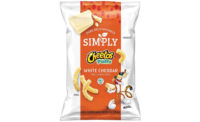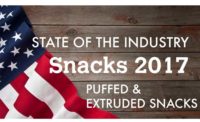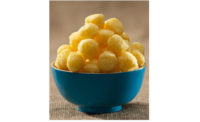State of the Industry 2018: Puffed and extruded snacks bring better-for-you diversity
Ingredient and technological innovations are driving all areas










Puffed and extruded snacks are experiencing a renaissance. There are many different types of snacks in this category for shoppers to choose from, including traditional, healthier and even “free-from” options like gluten-free. Whole grains are getting in on the action, including specialty grains like quinoa. Pulses, legumes and vegetables also go into the mix. And every primary product category within this salty snack format—from cheese snacks to pork rinds—is experiencing growth.
Overview | Chips | Puffed/Extruded Snacks | Popcorn | Snack Mixes & Nuts | Tortilla Chips | Pretzels | Frozen Snacks | Crackers
Market data
According to data from IRI, Chicago, over the past 52 weeks ending April 22, 2018, the “other salted snacks (no nuts)” segment within the $23.7 billion salty snacks category experienced an increase of 9.23 percent in sales, rising to $4.4 billion. PepsiCo’s Frito-Lay business far and away leads the segment with $2.8 billion in sales for the year, up 12.17 percent. Several of its top brands saw growth: Funyuns grew 4.78 percent to $378.3 million, Chester’s increased 11.23 to $288.9 million and SunChips grew 17.43 percent to $246.0 million. General Mills grew 1.96 percent to $462.7 million for the year. Its Chex Mix brand increased 2.44 percent to $286.9 million, while Gardetto’s remained relatively flat, up 0.26 percent to $109.9 million. The Hain Celestial group, although experiencing a slight decrease in sales by 6.23 percent, brought in $190 million in the category.
The cheese snacks segment grew by 7.73 percent to $2.3 billion, with segment leader Frito-Lay responsible for $2.0 billion of that revenue. Cheetos grew 6.22 percent to $1.7 billion, and Chester’s grew 13.18 percent to $133.6 million. The clean-label line Simply Cheetos grew 57.76 percent to $59.0 million, while Cheetos Paws grew 311.90 percent to $35.3 million.
In a glimpse of incremental growth of clean label in cheese snacks, the Arthur Schuman Inc. brand Cello Whisps—made from 100 percent cheese—grew 295.97 percent to $11.4 million.
Frito-Lay likewise is driving growth in corn snacks, which grew 2.50 percent to $1.2 billion. Fritos was responsible for $530.4 million of that revenue, up 4.51 percent. Fritos Scoops accounted for an additional $230.7 million, up 2.00 percent. Fritos Flavor Twists grew 3.85 percent to $136.2 million. The General Mills brand Bugles brought in $137.4 million, but dropped 4.16 percent.
Pork rinds saw another up year, growing 11.32 percent to $470.8 million. Frito-Lay leads with its Baken-Ets brand, up 7.28 percent to $132.3 million. Mac’s Snacks was up 12.61 percent to $61.2 million, and Golden Flake grew 11.61 percent to $51.3 million. Snyder’s-Lance—now part of Campbell Soup Co.—grew its pork rinds business by 9.07 percent to $27.6 million. Turkey Creek was up 14.54 percent to $22.4 million. Outside of the top five companies, Utz grew 7.10 percent to $15.3 million, Carolina Country grew 7.00 percent to $10.2 million, and Rudolph Foods saw strong growth of its Southern Recipe brand, up 89.25 percent to $7.9 million.
Looking back
“Healthy and ‘good for you’ products are still a major global trend that is supported by consumers’ increasing desire for natural and organic products,” says Gilles Maller, vice president, sales and international, Clextral, Firminy, France.
One example of the emerging better-for-you trend in puffed and extruded snacks is the World Peas brand Peatos, introduced in January 2018—made with pulses like peas and lentils, and loaded with protein and fiber. Such products have an ability to drive new levels of growth within shopper demographics not prone to purchasing traditional cheese puffs.
“Healthier, clean label, non-GMO and organic are trending in the food industry as a whole right now, and extruded snacks are no exception,” says Mark Stavro, senior director of marketing, Bunge, Chesterfield, MO. “Extruded snacks can range in health claims, depending on the ingredients used and how they are finished. With our pellet extrusions, you can incorporate vegetables, fruits, legumes and ancient-grain flours. They can then be finished by air-popping, expanding or frying, depending on the nutrition claims you’re seeking.”
Consumer demand for label-friendly ingredients is driving much of the upstart innovation in this space, notes Chad Rieschl, senior research technologist, Cargill, Minneapolis. “They want to recognize the ingredients in their snacks, know where those ingredients come from, and understand how they are made. As a whole, extruded and puffed snacks, with their simple bases made from corn or another grain, fit this trend.”
In December 2017, Kay’s Naturals released Pass the Peas, made from chickpea flour and pea protein. The snack is Non-GMO Project Verified, and comes in three flavors: Maple Bacon, Dill Pickle and Smoky BBQ.
“Brand owners seem to be exploring unusual ingredients with more regularity,” says Gunther Brinkman, vice president, contract manufacturing, Ideal Snacks Corp., Liberty, NY. “We are seeing requests for unusual grains and pulses, and—in a couple of cases—requests for specific specialty rice or corn strains.”
However, even though consumers want simplified ingredient statements and healthier snack options, they refuse to compromise on taste, says Rieschl. “The challenge for today’s snack maker is to deliver distinctive flavor experiences that keep consumers coming back for more.”
Looking forward
“Products with organic ingredients, in addition to natural colors and flavors, have launched widely and are being met with success—also snacks with high-protein ingredients, such as pulses,” comments Maller.
Consumers want to see whole grains, corn, vegetables, sweet potatoes, kale and ancient grains in their puffs, remarks Stavro. “Bunge uses those ingredients, as well as non-GMO and organic ingredients, and expeller-pressed oils.” He suggests that extruded snacks are great vehicles for unique spices and ethnic flavors, which are trending right now.
Maller says that there’s a trend toward “premiumization” of snack products that are more exclusive and highly targeted toward niche markets. Also, multiple-textured snacks are becoming popular due to their higher quality perception. “Extruded, multi-textured snacks typically have a crispy outer shell with a soft filling that combines a dual-textured mouthfeel and a blend of two flavors in each bite.”
Clextral’s Evolum+ twin-screw extruder helps producers create these dynamic snacks. The extruder offers proprietary ATC (Advanced Thermal Control), and the controller adapts automatically to new recipes. Clextral also offers a range of “clip-ons” that provide the functionality to create specific product attributes such as custom shapes, special cuts or special textures, notes Maller.
Extruded snacks are a perfect vehicle for packing in extra protein, says Rieschl, and Cargill manufactures its PURIS pea protein as an option. “Flavor can be a challenge with some novel proteins, but options like PURIS pea protein provide a great base, making it much easier for product developers to achieve their flavor targets.”
Interest in non-GMO ingredients is increasing, too, and to help customers tap into that niche market, Cargill has received Non-GMO Project Verification for a number of its products, including dry corn ingredients, corn syrups, native starches and stevia sweeteners, notes Rieschl.
Brinkman predicts that sorghum and beans will see a rise in interest in the coming year. “Sorghum seems to be on the rise, and since some strains pop nicely, we have seen some really interesting applications. Since elevated protein levels are still on lots of brand owners’ radars, we are seeing a variety of beans showing up in our development projects, too.”
Consumers will also continue to seek “fresh and different” options, continually seeking out new products with limited loyalty to any particular brand or product, says Rieschl. “With a bit of creativity, product developers can develop label-friendly snacks that use natural plant fibers and unique plant protein blends to create products that stand out in the marketplace.”
Overview | Chips | Puffed/Extruded Snacks | Popcorn | Snack Mixes & Nuts | Tortilla Chips | Pretzels | Frozen Snacks | Crackers
Looking for a reprint of this article?
From high-res PDFs to custom plaques, order your copy today!












